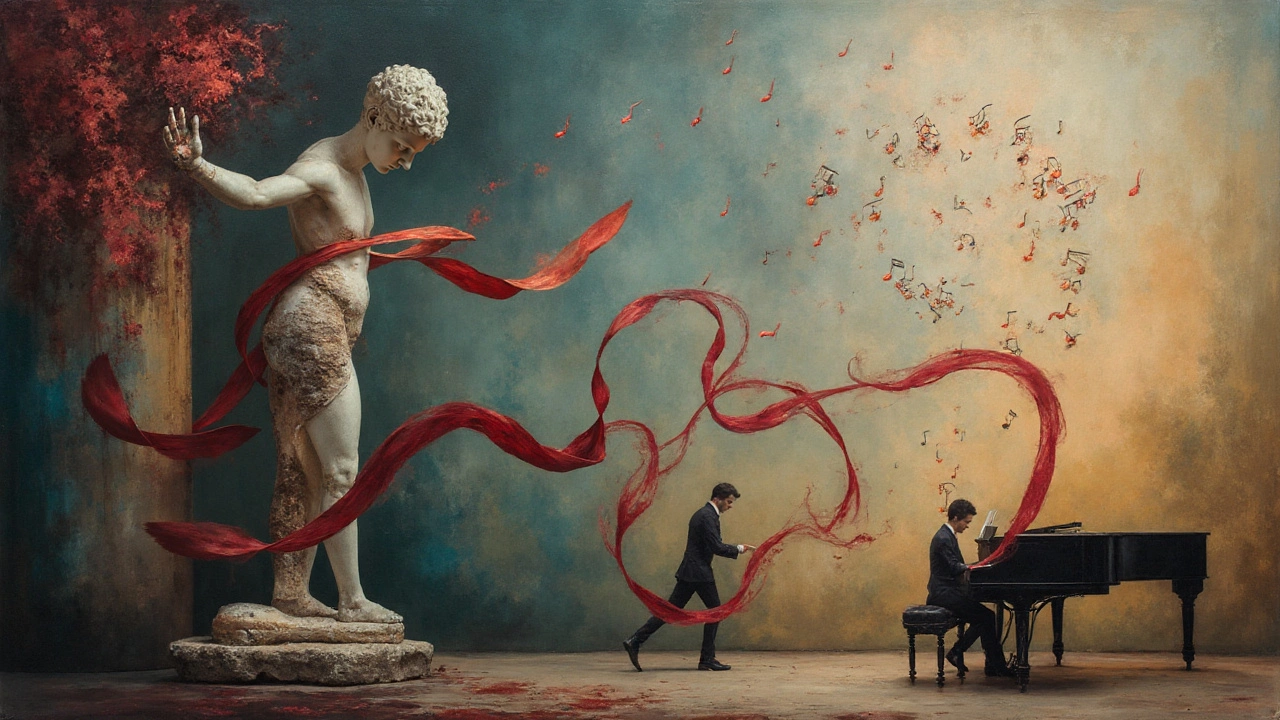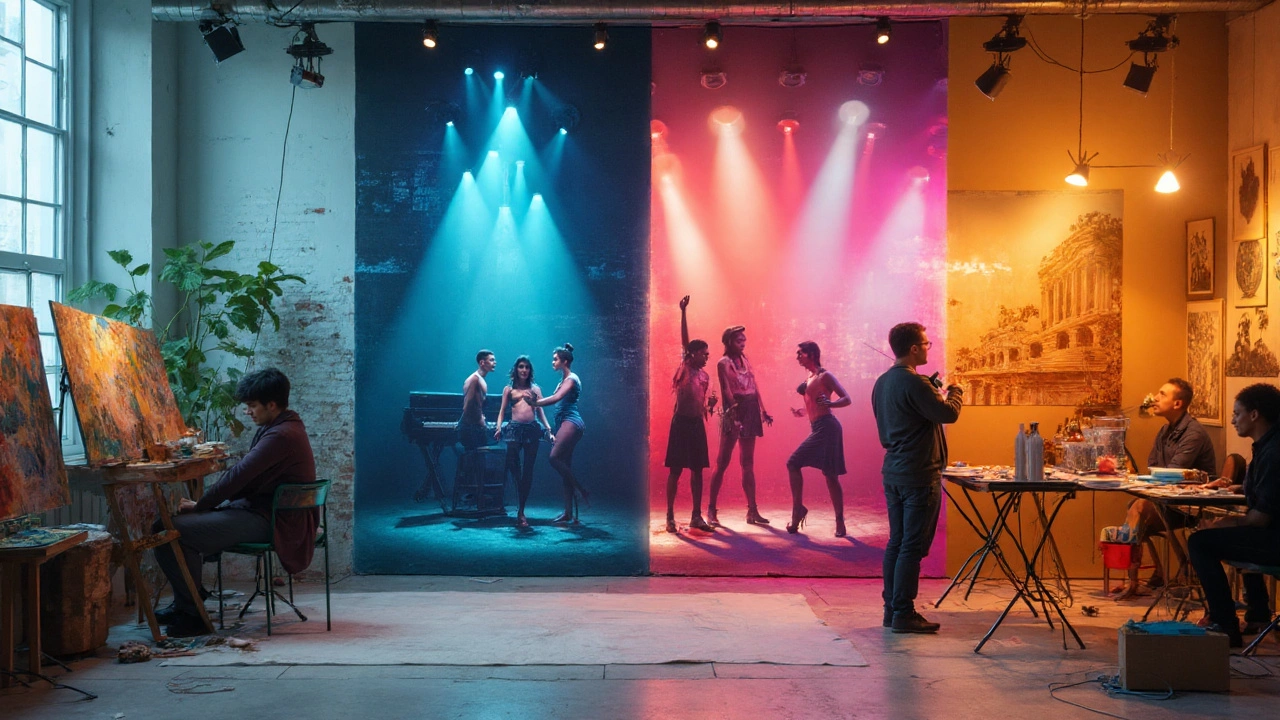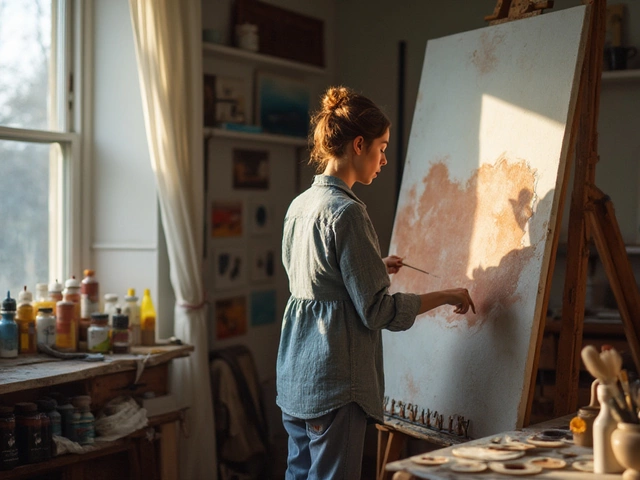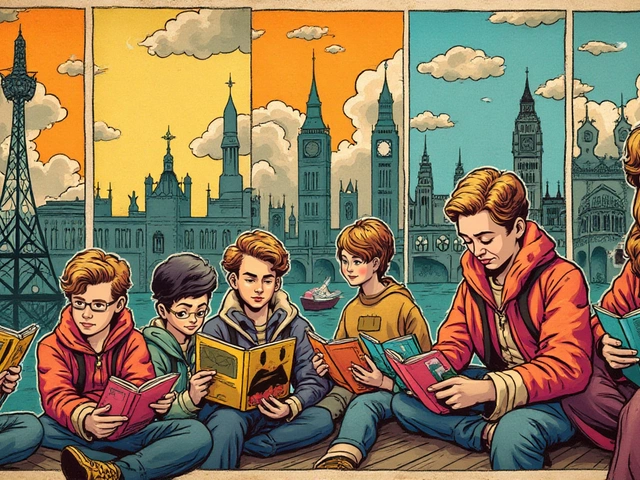Why does art make us stop and look twice? Sometimes you see a painting, or hear a song, or watch a movie, and it just sticks in your head. Art isn’t some far-off thing for dusty museums. It’s right here—on your playlist, your favorite hoodie, and even in two guys balancing sculptures on a beach. But here’s something that surprises people: when folks talk about the “seven arts,” they’re not making it up. Hundreds of years ago, thinkers actually listed out what they saw as the seven main types of art. Sure, the list got tweaked over the centuries, but those seven areas still hold up today. Except art’s gotten weirder, wilder, and a lot more fun.
The Seven Areas of Art: What Counts and Why?
The seven areas that make the big list are painting, sculpture, architecture, literature, music, performing arts (like theater and dance), and cinema. Each one has a story, and if you think they’re simple or just “nice to look at,” you’re missing half the point.
Take painting. Crayons, spray cans, cave walls—humans have always wanted to leave a mark. An average painting auctioned at Sotheby’s can fetch millions. Vincent van Gogh? The guy only sold one painting in his life. Now, "Starry Night" is everywhere from museum walls to bedroom posters. Painting is more than a pretty picture—it’s a time machine in color, telling stories about everything from epic wars to tiny bowls of fruit.
Sculpture is a whole different beast. It’s ancient—think of those 40,000-year-old lion statues found in German caves. Modern sculptors, like Jeff Koons, turn balloon animals into shiny, giant metal pieces you can’t ignore. Some artists use junkyard scraps. Others carve marble with the same tools Michelangelo used on David. Sculptures change how we walk through a space—they’re too stubborn to be ignored.
Architecture mixes math with creativity. Even if you don’t know Gaudí by name, you’ve probably seen Barcelona’s Sagrada Família—a cathedral that looks like it melted during a fever dream. Good architecture makes a place inviting or intimidating, warm or sterile. Tokyo’s capsule hotels? Brutalist concrete towers? That’s art you live in, not just look at.
Now let’s talk literature. Some folks say words can’t be art, but you’ve never been hit by a line from Maya Angelou or Gabriel García Márquez, then. Storytelling is wired into our DNA—just look at how fast viral Twitter threads spread, or how literary classics still end up on new Netflix drama adaptations.
Music doesn’t need words to make you feel something. Two notes, and jaws drop—think of the opening to “Jaws” or Beethoven’s Fifth Symphony. You don’t have to read sheet music to hum along, either. The fun part? There are more music genres today than ever, and thanks to streaming, you can hop from Mozart to K-pop in ten seconds flat. Global streaming audiences for music went past 680 million in 2024 according to figures from the IFPI.
Performing arts is everything on stage. Theater, dance, opera. It’s nerves backstage and standing ovations. Broadway’s “Hamilton” made $649.9 million in ticket sales by its eighth year, showing that live performance doesn’t just survive—it electrifies. And at any given night, people line up for everything from street buskers to ballet, all chasing that thrill of seeing something magic happen live.
Cinema rounds out the group, the “seventh art.” Silent films in the 1920s, “Star Wars” in the 70s, indie flicks today—movies shape how we see heroism, heartbreak, and humor. Last year, global movie ticket sales zipped past $35 billion (courtesy of the Motion Picture Association). So, if you ever wondered why an old black-and-white movie still gets quoted, that’s why.
Together, these seven areas shape everything from TikTok dance crazes to how cities get designed. It’s not just “artsy types” who should care. Whether you realize it or not, you’re already soaking up art just about everywhere you look.
Here’s a handy table with some fun data:
| Area of Art | Famous Example | First Known Forms | 2024 Stats or Fun Fact |
|---|---|---|---|
| Painting | Starry Night (Van Gogh) | Prehistoric cave art | Highest painting sale: $195M (Warhol’s "Marilyn") |
| Sculpture | David (Michelangelo) | Stone figurines ~40,000 BC | Largest sculpture: Statue of Unity (182m, India) |
| Architecture | Sagrada Família | Primitive huts | Burj Khalifa holds 12 world records |
| Literature | Romeo & Juliet | Epic of Gilgamesh (~2100 BC) | 1M+ new books published every year |
| Music | Beethoven’s Ninth | Bone flutes (~40,000 BC) | Spotify hosts >100M tracks |
| Performing Arts | Hamilton (Musical) | Greek tragedy (~500 BC) | Edinburgh Fringe: 3,841 shows, 2024 |
| Cinema | Citizen Kane | Short films (late 1800s) | Top 10 films grossed >$10B, 2024 |

How Art Shapes the Way We See and Feel
Ever walk into a friend’s house and get a vibe right away? It can be the color on the walls or a weird lamp—that’s art, doing its job before you say a word. These seven art areas aren’t just museum stuff. They set the mood for everything: a concert lifts you up, a scary movie gets the heart racing, a mural on a drab building makes your commute less boring. The way artists blend sound, space, color, and movement changes how you feel about the world, whether it’s for five seconds or a lifetime.
Think about how music impacts a blockbuster movie. John Williams’ “Imperial March” practically turned Darth Vader into a worldwide icon. Or how one novel can shape a generation—“Harry Potter” inspired midnight bookstore lines, costume parties, and new baby names. Then there’s architecture. The layout of a school, hospital, or museum can make you feel safe, inspired, or totally lost. Architects like Frank Lloyd Wright designed entire houses around the way sunlight fell at certain times of day.
Performing arts work best when you see them live. There’s something wild about watching a dancer nail a leap, or an actor own the stage without a safety net. According to the 2023 U.K. Survey of Performing Arts, 74% of regular theater-goers said seeing a play live left a stronger impression than streaming it at home. Makes sense—you’re sharing the energy with 500 strangers, and for two hours, everyone’s breathing in rhythm. That kind of magic sticks around.
Literature might seem like a solo thing, but the stories you read often get talked about over dinner, reshaped into memes, or even spark protests. The 2024 PEN America Report found that 1 in 6 American adults picked up a book last year after hearing it was controversial. Books change minds, even if you don’t finish every chapter.
Sculpture and painting often show up in public spaces, quietly doing their work. Ever wondered why some cities look dull while others have a vibe? Murals, public art, and even quirky benches play a part. Philadelphia started its Mural Arts Program back in 1984 to fight graffiti and crime, and now it has over 4,000 works—turning drab blocks into Instagram hotspots.
Cinema may not be “real life,” but how people talk, dress, and even fall in love often tugs from big films. In 2024, a survey by the Motion Picture Association found that 83% of Gen Z viewers identified at least one personal style change tied to a movie or show they’d watched. Art isn’t extra—it’s driving our culture car, pedal to the metal.
Sometimes, art is just fun. Dance crazes. TikTok challenges. Fanfic stories and indie songs recorded in basements. In a way, everyone’s an artist, or at least part of the show.

Useful Tips: Experiencing and Creating Art in Everyday Life
Don’t let the phrase “area of art” trip you up—it’s about exploring, not passing a test. Want to get more art into your world, or even try your hand at creating? Here’s some no-nonsense advice for beginners (and bored pros):
- Find what grabs you first. If murals make you stop and stare, start there. Bored in a museum? Try the sculpture garden before the portrait hall.
- Mix digital with real life. The Louvre livestreams tours, and orchestras post free concerts online. But don’t skip the thrill of seeing something up close—there’s nothing like standing face-to-face with a painting older than Paris.
- Don’t worry about “getting it.” Even experts argue over what counts as art. Just describe what you see or feel. Saying, "It makes me hungry," or "It reminds me of last winter," is more honest than nervous silence.
- Join the conversation. Post a pic, tag the artist, or leave a review. Art flourishes when people talk about it, even if they disagree.
- Try making a little art. Doodle during work calls. Write a weird short story. Bust out a cheesy karaoke performance. Your creation doesn’t need to belong in a gallery—if it meant something in the moment, that’s enough.
Maybe you’re still not sure how the “seven areas” connect to you. Try this: look around. Someone painted that road sign, designed the billboard, planned the shape of the building you’re sitting in, and probably chose the speaker system piping music near your seat. You’re surrounded by art—sometimes wild, sometimes subtle, but always there. And if you want in, all you have to do is start looking closer.



